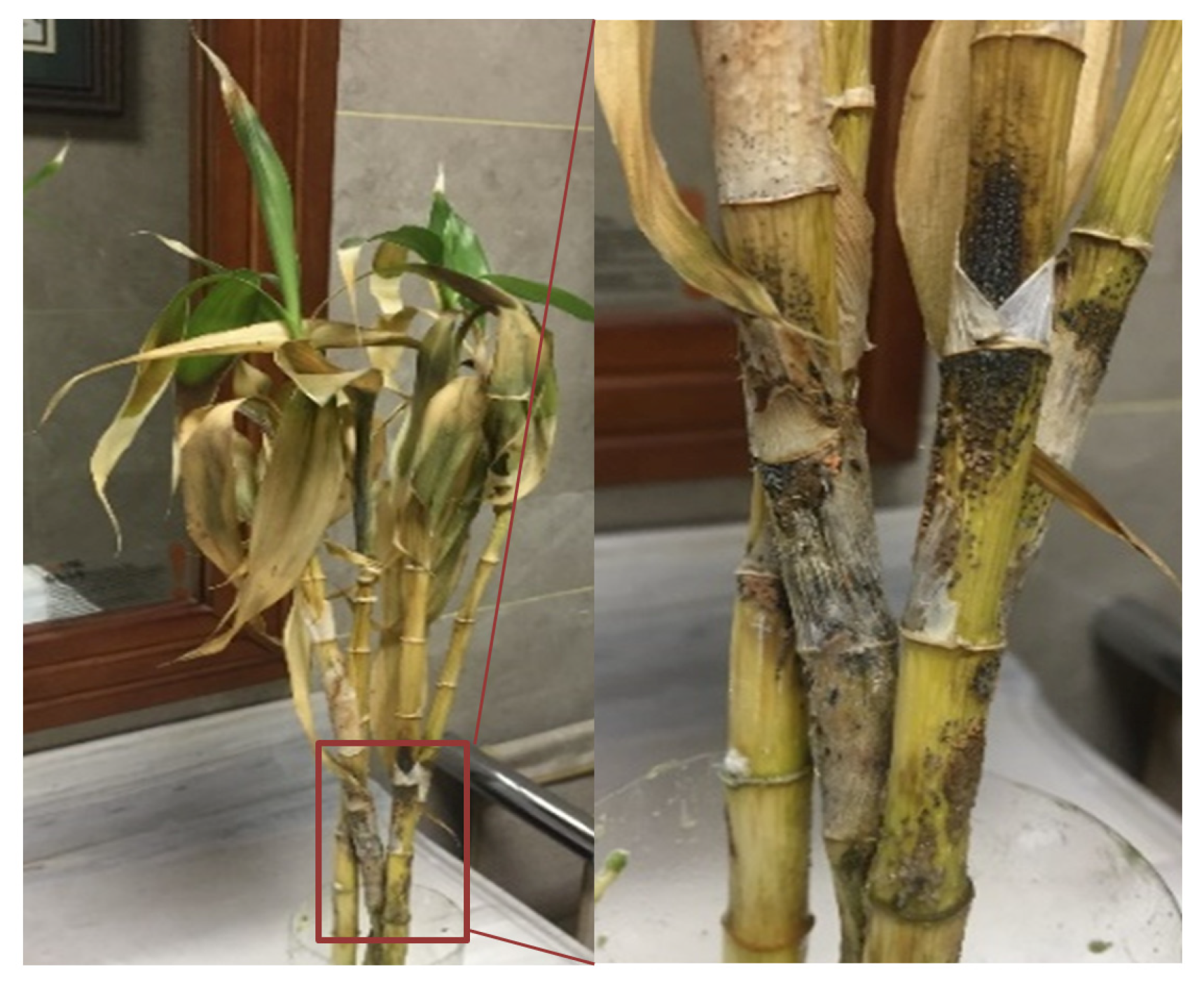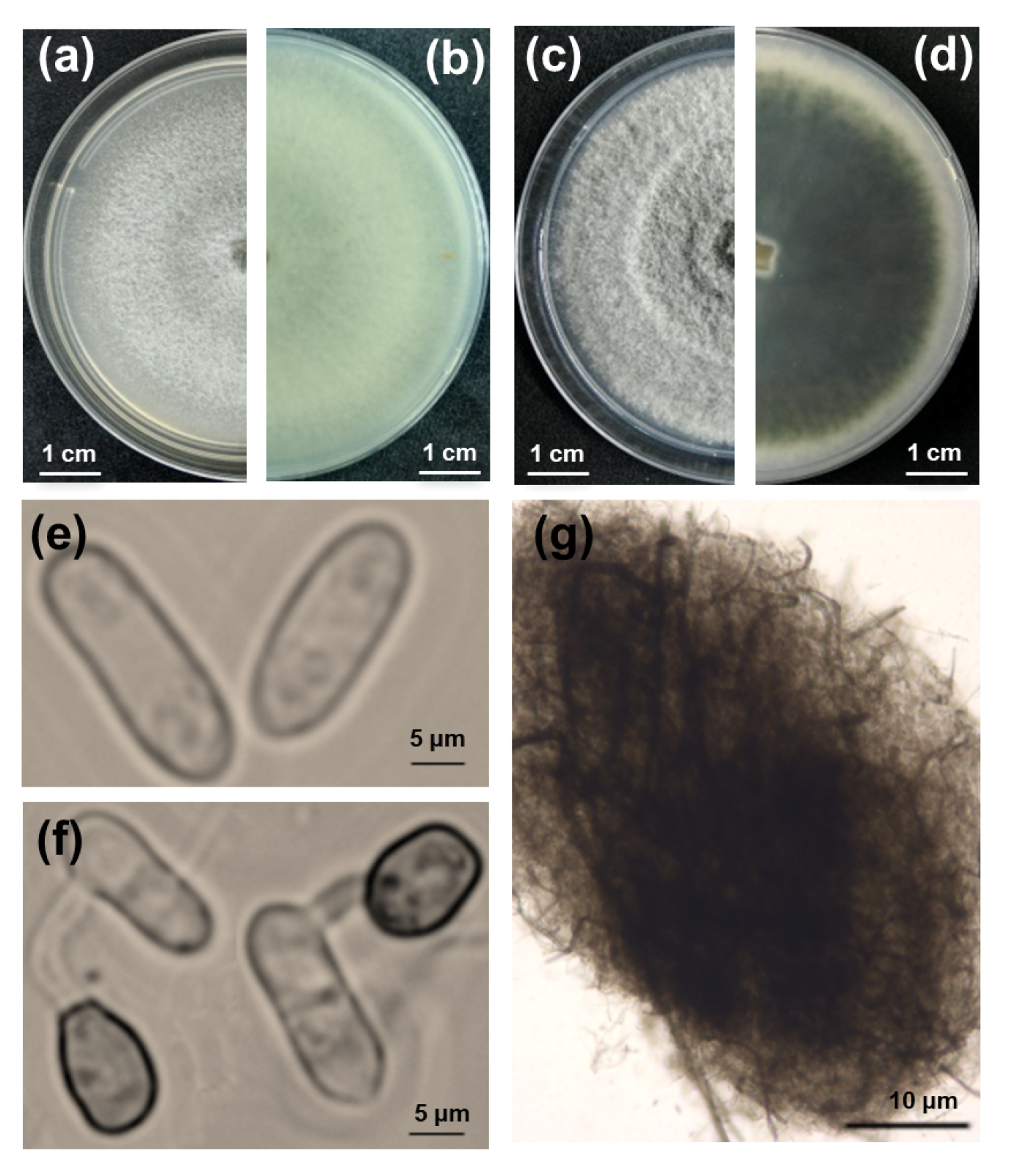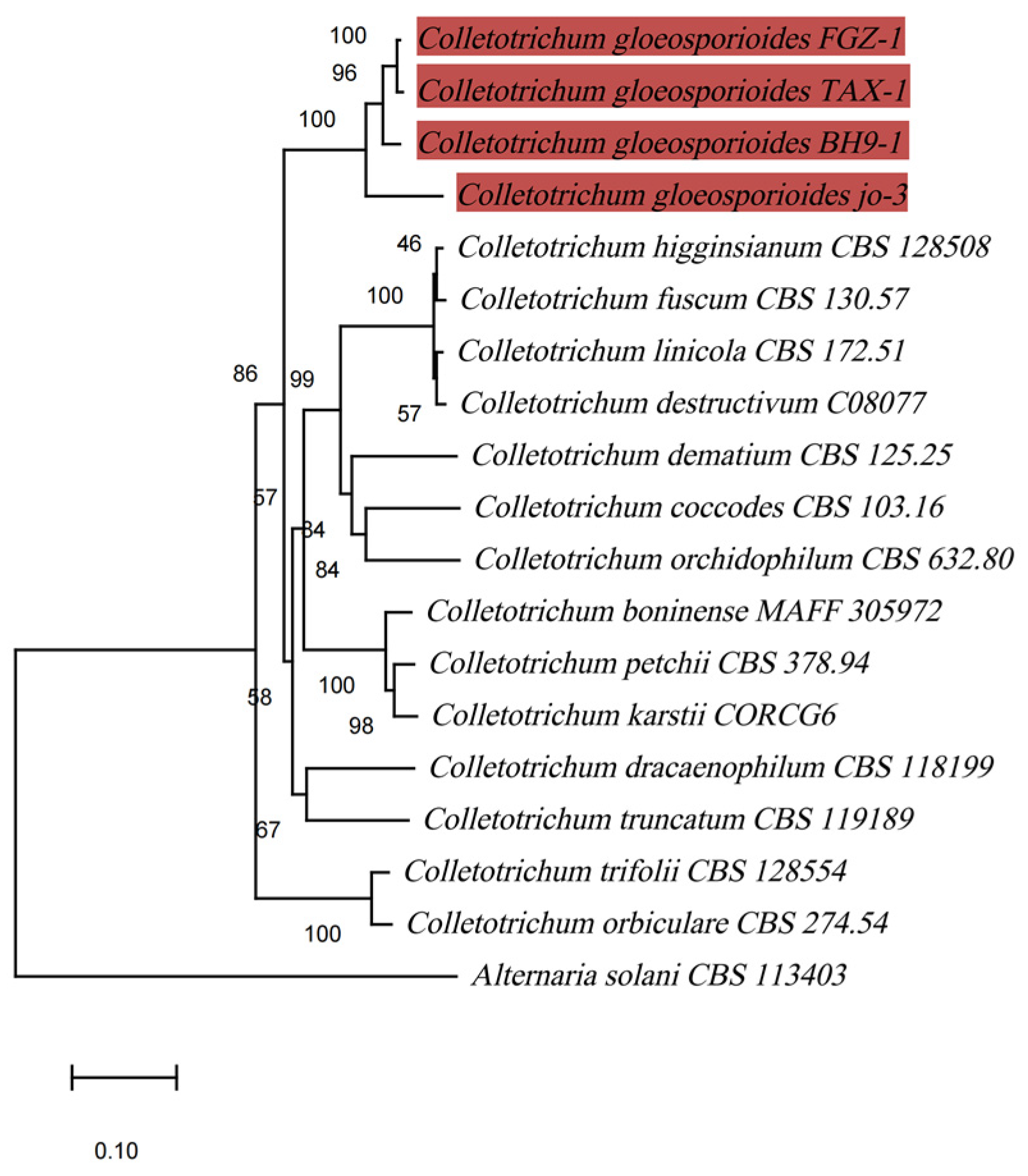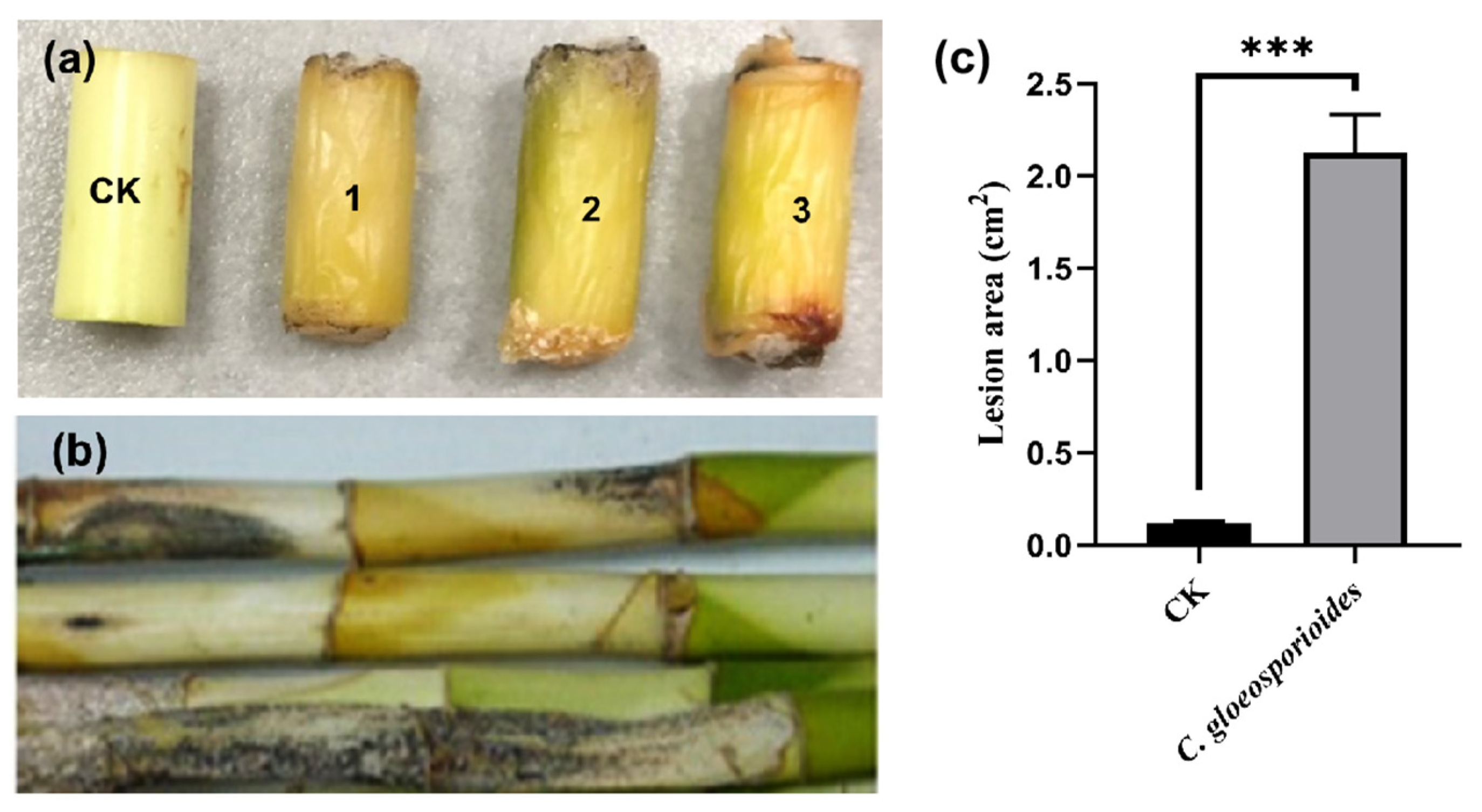First Report of Anthracnose Caused by Colletotrichum gloeosporioides on Lucky Bamboo in China
Abstract
1. Introduction
2. Materials and Methods
2.1. Sampling and Isolation
2.2. DNA Extraction, PCR Amplification, and Sequencing
2.3. Sequence Alignment and Phylogenetic Analysis
2.4. Morphology Assay
2.5. Pathogenicity Assay
3. Results
3.1. Isolation and Morphological Characteristics of Isolates
3.2. Molecular Characterization
3.3. Phylogenetic Analysis
3.4. Pathogenicity Tests
4. Discussion
5. Conclusions
Supplementary Materials
Author Contributions
Funding
Data Availability Statement
Acknowledgments
Conflicts of Interest
References
- Abdel-Rahman, T.F.; Abdel-Megeed, A.; Salem, M.Z. Characterization and control of Rhizoctonia solani affecting lucky bamboo (Dracaena sanderiana hort. ex. Mast.) using some bioagents. Sci. Rep. 2023, 13, 6691. [Google Scholar] [CrossRef] [PubMed]
- Junaid, A.; Mujib, A.; Sharma, M. Cell and tissue culture of Dracaena sanderiana Sander ex Mast: A review. Hamdard Med. 2009, 52, 31–35. [Google Scholar]
- Morsy, A.A.; Elshahawy, I.E. Anthracnose of lucky bamboo Dracaena sanderiana caused by the fungus Colletotrichum dracaenophilum in Egypt. J. Adv. Res. 2016, 7, 327–335. [Google Scholar] [CrossRef]
- Chongtham, N.; Bisht, M.S. Bamboo Shoot: Superfood for Nutrition, Health and Medicine; CRC Press: Boca Raton, FL, USA, 2020. [Google Scholar]
- Hilal, A.; El-Argawy, E.; Korany, A.E.; Fekry, T. Chemical and biological control of Dracaena marginata leaf spots in northern Egypt. Int. J. Agric. Biol. 2016, 18, 1201–1212. [Google Scholar] [CrossRef]
- Santos, M.V.O.D.; Luz, E.D.M.N.; de Souza, J.T. First record of Phytophthora nicotianae causing leaf blight on Dracaena sanderiana. New Dis. Rep. 2011, 24, 28. [Google Scholar] [CrossRef]
- Zhang, S.; Xu, Z.Y.; Le, R.; Hu, H.Q. First Report of Leaf Blight Wilt on Dracaena sanderiana by Pantoea stewartii subsp. indologenes in China. Plant Dis. 2020, 104, 1854. [Google Scholar] [CrossRef]
- Abbasi, M.; Aliabadi, F. First report of stem rot of Dracaena caused by Aspergillus niger in Iran. Plant Health Prog. 2008, 9, 48. [Google Scholar] [CrossRef]
- Abedi-Tizaki, M.; Zafari, D.; Sadeghi, J. First report of Fusarium solani causing stem rot of Dracaena in Iran. J. Plant Prot. Res. 2016, 56, 100–103. [Google Scholar] [CrossRef]
- Lahuf, A.A. First report of causing stem and root rot on lucky bamboo (Dracaena braunii) in Iraq. Hell. Plant Prot. J. 2019, 12, 1–5. [Google Scholar] [CrossRef]
- Kim, S.-W.; Jeong, Y.; Yang, K.-Y.; Jeong, R.-D. First report of natural infection of Dracaena braunii by pepper mild mottle virus in Korea. J. Plant Pathol. 2022, 104, 1579. [Google Scholar] [CrossRef]
- Chaiwan, N.; Tibpromma, S.; Jayawardena, R.; Mapook, A.; Wanasinghe, D.; Mortimer, P.; Lumyong, S.; Hyde, K. Colletotrichum dracaenigenum, a new species on Dracaena fragrans. Phytotaxa 2021, 491, 143–157. [Google Scholar] [CrossRef]
- Bobev, S.G.; Castlebury, L.A.; Rossman, A.Y. First report of Colletotrichum dracaenophilum on Dracaena sanderiana in Bulgaria. Plant Dis. 2008, 92, 173. [Google Scholar] [CrossRef]
- Komaki, A.M.; Aghapour, B.; Aghajani, M.A. First report of Colletotrichum dracaenophilum on Dracaena sanderiana. Rostaniha 2012, 13, 111–112. [Google Scholar] [CrossRef]
- Sharma, K.; Merritt, J.L.; Palmateer, A.; Goss, E.; Smith, M.; Schubert, T.; Johnson, R.S.; van Bruggen, A.H.C. Isolation, characterization, and management of Colletotrichum spp. causing anthracnose on lucky bamboo (Dracaena sanderiana). HortSci. Horts 2014, 49, 453–459. [Google Scholar] [CrossRef]
- Macedo, D.M.; Barreto, R.W. Colletotrichum dracaenophilum causes anthracnose on Dracaena braunii in Brazil. Australas. Plant Dis. Notes 2016, 11, 5. [Google Scholar] [CrossRef]
- Li, Y.L.; Yan, Z.B.; Wang, Y.H.; Lin, Q.K.; Wang, S.B.; Zhou, Z. First report of Colletotrichum karstii causing anthracnose on lotus bamboo (Dracaena sanderiana) in China. Plant Dis. 2018, 102, 2641. [Google Scholar] [CrossRef]
- Liu, Y.L.; Lu, J.N.; Zhou, Y.H. First report of Colletotrichum truncatum causing anthracnose of lucky bamboo in Zhanjiang, China. Plant Dis. 2019, 103, 2947. [Google Scholar] [CrossRef]
- Dean, R.; Van Kan, J.A.; Pretorius, Z.A.; Hammond-Kosack, K.E.; Di, P.A.; Spanu, P.D.; Rudd, J.J.; Dickman, M.; Kahmann, R.; Ellis, J.; et al. The Top 10 fungal pathogens in molecular plant pathology. Mol. Plant Pathol. 2012, 13, 414–430. [Google Scholar] [CrossRef]
- Dowling, M.; Peres, N.; Villani, S.; Schnabel, G. Managing Colletotrichum on Fruit Crops: A “Complex” Challenge. Plant Dis. 2020, 104, 2301–2316. [Google Scholar] [CrossRef] [PubMed]
- Wang, Q.H.; Fan, K.; Li, D.W.; Han, C.M.; Qu, Y.Y.; Qi, Y.K.; Wu, X.Q. Identification, virulence and fungicide sensitivity of Colletotrichum gloeosporioides s.s. responsible for walnut anthracnose disease in China. Plant Dis. 2020, 104, 1358. [Google Scholar] [CrossRef] [PubMed]
- Fei, L.; Lu, W.; Xu, X.; Yan, F.; Zhang, L.; Liu, J.; Bai, Y.; Li, Z.; Zhao, W.; Yang, J.; et al. A rapid approach for isolating a single fungal spore from rice blast diseased leaves. J. Integr. Agric. 2019, 18, 1415–1418. [Google Scholar] [CrossRef]
- Xiong, Q.; Xu, J.; Zhao, Y.; Wang, K. CtPMK1, a mitogen-activated-protein kinase gene, is required for conidiation, appressorium formation, and pathogenicity of Colletotrichum truncatum on soybean. Ann. Appl. Biol. 2015, 167, 63–74. [Google Scholar] [CrossRef]
- White, T.J.; Bruns, T.; Lee, S.; Taylor, J. Amplification and direct sequencing of fungal ribosomal RNA genes for phylogenetics. PCR Protoc. A Guide Methods Appl. 1990, 18, 315–322. [Google Scholar]
- Carbone, I.; Kohn, L.M. A method for designing primer sets for speciation studies in filamentous ascomycetes. Mycologia 1999, 91, 553–556. [Google Scholar] [CrossRef]
- Guerber, J.C.; Liu, B.; Correll, J.C.; Johnston, P.R. Characterization of diversity in Colletotrichum acutatum sensu lato by sequence analysis of two gene introns, mtDNA and intron RFLPs, and mating compatibility. Mycologia 2003, 95, 872–895. [Google Scholar] [CrossRef] [PubMed]
- Sambrook, J.; Fritsch, E.F.; Maniatis, T. Molecular Cloning; Cold Spring Harbor Laboratory Press: New York, NY, USA, 1989; Volume 2. [Google Scholar]
- Katoh, K.; Rozewicki, J.; Yamada, K.D. MAFFT online service: Multiple sequence alignment, interactive sequence choice and visualization. Brief. Bioinform. 2017, 20, 1160–1166. [Google Scholar] [CrossRef] [PubMed]
- Liu, K.; Warnow, T.J.; Holder, M.T.; Nelesen, S.M.; Yu, J.; Stamatakis, A.P.; Linder, C.R. SATé-II: Very fast and accurate simultaneous estimation of multiple sequence alignments and phylogenetic trees. Syst. Biol. 2012, 61, 90. [Google Scholar] [CrossRef] [PubMed]
- Tamura, K.; Nei, M. Estimation of the number of nucleotide substitutions in the control region of mitochondrial DNA in humans and chimpanzees. Mol. Biol. Evol. 1993, 10, 512–526. [Google Scholar] [PubMed]
- Kumar, S.; Stecher, G.; Li, M.; Knyaz, C.; Tamura, K. MEGA X: Molecular evolutionary genetics analysis across computing platforms. Mol. Biol. Evol. 2018, 35, 1547–1549. [Google Scholar] [CrossRef]
- Xiong, Q.; Zhang, L.; Waletich, J.; Zhang, L.; Zhang, C.; Zheng, X.; Qian, Y.; Zhang, Z.; Wang, Y.; Cheng, Q. Characterization of the papain-like protease p29 of the Hypovirus CHV1-CN280 in its natural host fungus Cryphonectria parasitica and nonhost fungus Magnaporthe oryzae. Phytopathology® 2019, 109, 736–747. [Google Scholar] [CrossRef]
- Gao, K.; Xiong, Q.; Xu, J.; Wang, K.J.; Wang, K.R. CpBir1 is required for conidiation, virulence and anti-apoptotic effects and influences hypovirus transmission in Cryphonectria parasitica. Fungal Genet. Biol. 2013, 50, 60–71. [Google Scholar] [CrossRef] [PubMed]
- Yang, Y.; Liu, Z.; Cai, L.; Hyde, K.; Yu, Z.; McKenzie, E. Colletotrichum anthracnose of Amaryllidaceae. Fungal Divers. 2009, 39, 123–146. [Google Scholar]
- Ye, B.; Zhang, J.; Chen, X.; Xiao, W.; Wu, J.; Yu, H.; Zhang, C. Genetic diversity of Colletotrichum spp. causing grape anthracnose in Zhejiang, China. Agronomy 2023, 13, 952. [Google Scholar] [CrossRef]
- Damm, U.; Sato, T.; Alizadeh, A.; Groenewald, J.Z.; Crous, P.W. The Colletotrichum dracaenophilum, C. magnum and C. orchidearum species complexes. Stud. Mycol. 2019, 92, 1–46. [Google Scholar] [CrossRef]
- Agostini, J.P.; Timmer, L.W.; Mitchell, D. Morphological and pathological characteristics of strains of Colletotrichum gloeosporioides from citrus. Phytopathology 1992, 82, 1377–1382. [Google Scholar] [CrossRef]
- Farr, D.; Rossman, A. Fungal Databases, US National Fungus Collections, ARS, USDA. Retrieved 16 January 2018. Available online: https://fungi.ars.usda.gov/ (accessed on 23 January 2021).
- Elshahawy, I.E.; Darwesh, O.M. Preventive and curative effect of difenoconazole + azoxytrobin and thiophanate-methyl against lucky bamboo anthracnose disease caused by Colletotrichum dracaenophilum. Heliyon 2023, 9, 3. [Google Scholar] [CrossRef] [PubMed]
- Aslam, J.; Mujib, A.; Sharma, M.P. In vitro micropropagation of Dracaena sanderiana Sander ex Mast: An important indoor ornamental plant. Saudi J. Biol. Sci. 2013, 20, 63–68. [Google Scholar] [CrossRef] [PubMed]
- Jayawardena, R.S.; Hyde, K.D.; Damm, U.; Cai, L.; Yan, J.Y. Notes on currently accepted species of Colletotrichum. Mycosphere 2016, 7, 1192–1260. [Google Scholar] [CrossRef]
- Liu, F.; Wang, M.; Damm, U.; Crous, P.W.; Cai, L. Species boundaries in plant pathogenic fungi: A Colletotrichum case study. BMC Evol. Biol. 2016, 16, 81. [Google Scholar] [CrossRef]




| Species | Strain No. 1 | GenBank Accession Number (ITS, ACT and GAPDH) 2 | ||
|---|---|---|---|---|
| ITS | ACT | GAPDH | ||
| C. gloeosporioides | FGZ-1 | MH752444.1 | MH757114.1 | MH757113.1 |
| Tax-1 | KR075160.1 | KX185669.1 | KX378683.1 | |
| BH9-1 | AB632351.1 | JN184702.1 | JN211078.1 | |
| jo-3 | MN913584.1 | MN919196.1 | MN919195.1 | |
| C. dracaenophilum | CBS 118199 | JX519222.1 | JX519238.1 | JX546707.1 |
| C. boninense | MAFF 305972 | AB051400.1 | HM582001.1 | GQ221769.1 |
| C. petchii | CBS 378.94 | JQ005223.1 | JQ005571.1 | JQ005310.1 |
| C. fuscum | CBS 130.57 | JQ005762.1 | JQ005825.1 | KM105530.1 |
| C. higginsianum | CBS 128508 | KM105190.1 | KM105400.1 | KM105543.1 |
| C. linicola | CBS 172.51 | JQ005765.1 | JQ005828.1 | KM105581.1 |
| C. destructivum | C08077 | GU935874.1 | GU935795.1 | GU935854.1 |
| C. dematium | CBS 125.25 | MH854810.1 | GU227917.1 | GU228211.1 |
| C. coccodes | CBS 103.16 | JX546820.1 | JX546628.1 | JX546724.1 |
| C. orbiculare | CBS 274.54 | KF178462.1 | KF178559.1 | KF178486.1 |
| C. trifolii | CBS 128554 | MH865019.1 | KF178573.1 | KF178500.1 |
| C. truncatum | CBS 119189 | GU227863.1 | GU227961.1 | GU228255.1 |
| C. orchidophilum | CBS 632.80 | JQ948151.1 | JQ949472.1 | Q948481.1 |
| C. karstii | CORCG6 | HM585409.1 | HM581995.1 | HM585391.1 |
| Alternaria solani * | CBS 113403 | KJ718243.1 | JQ646233.1 | JQ646333.1 |
Disclaimer/Publisher’s Note: The statements, opinions and data contained in all publications are solely those of the individual author(s) and contributor(s) and not of MDPI and/or the editor(s). MDPI and/or the editor(s) disclaim responsibility for any injury to people or property resulting from any ideas, methods, instructions or products referred to in the content. |
© 2025 by the authors. Licensee MDPI, Basel, Switzerland. This article is an open access article distributed under the terms and conditions of the Creative Commons Attribution (CC BY) license (https://creativecommons.org/licenses/by/4.0/).
Share and Cite
Qian, Y.; Wang, X.; Zhai, X.; Hu, X.; Li, T.; Li, Y.; Xiong, Q. First Report of Anthracnose Caused by Colletotrichum gloeosporioides on Lucky Bamboo in China. Forests 2025, 16, 128. https://doi.org/10.3390/f16010128
Qian Y, Wang X, Zhai X, Hu X, Li T, Li Y, Xiong Q. First Report of Anthracnose Caused by Colletotrichum gloeosporioides on Lucky Bamboo in China. Forests. 2025; 16(1):128. https://doi.org/10.3390/f16010128
Chicago/Turabian StyleQian, Yulin, Xueying Wang, Xiaoying Zhai, Xuehui Hu, Tao Li, Yuyang Li, and Qin Xiong. 2025. "First Report of Anthracnose Caused by Colletotrichum gloeosporioides on Lucky Bamboo in China" Forests 16, no. 1: 128. https://doi.org/10.3390/f16010128
APA StyleQian, Y., Wang, X., Zhai, X., Hu, X., Li, T., Li, Y., & Xiong, Q. (2025). First Report of Anthracnose Caused by Colletotrichum gloeosporioides on Lucky Bamboo in China. Forests, 16(1), 128. https://doi.org/10.3390/f16010128






